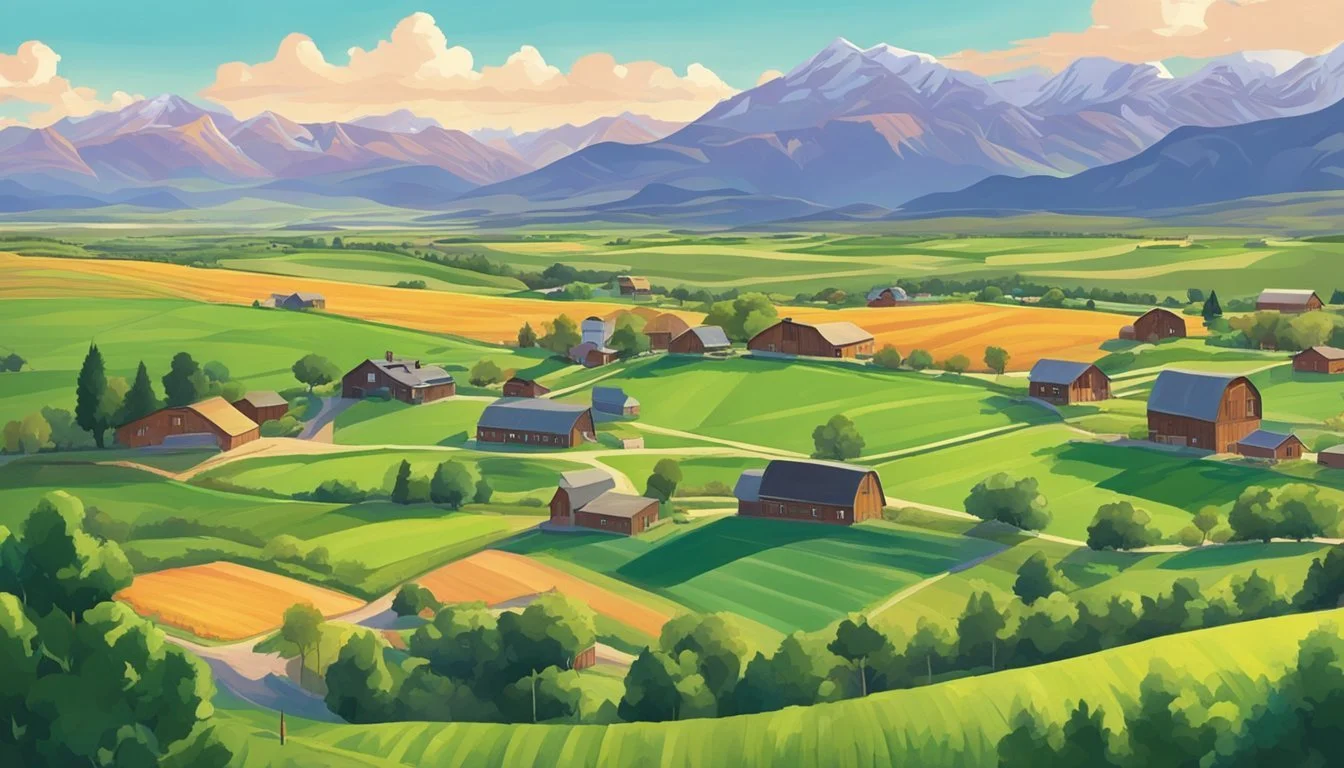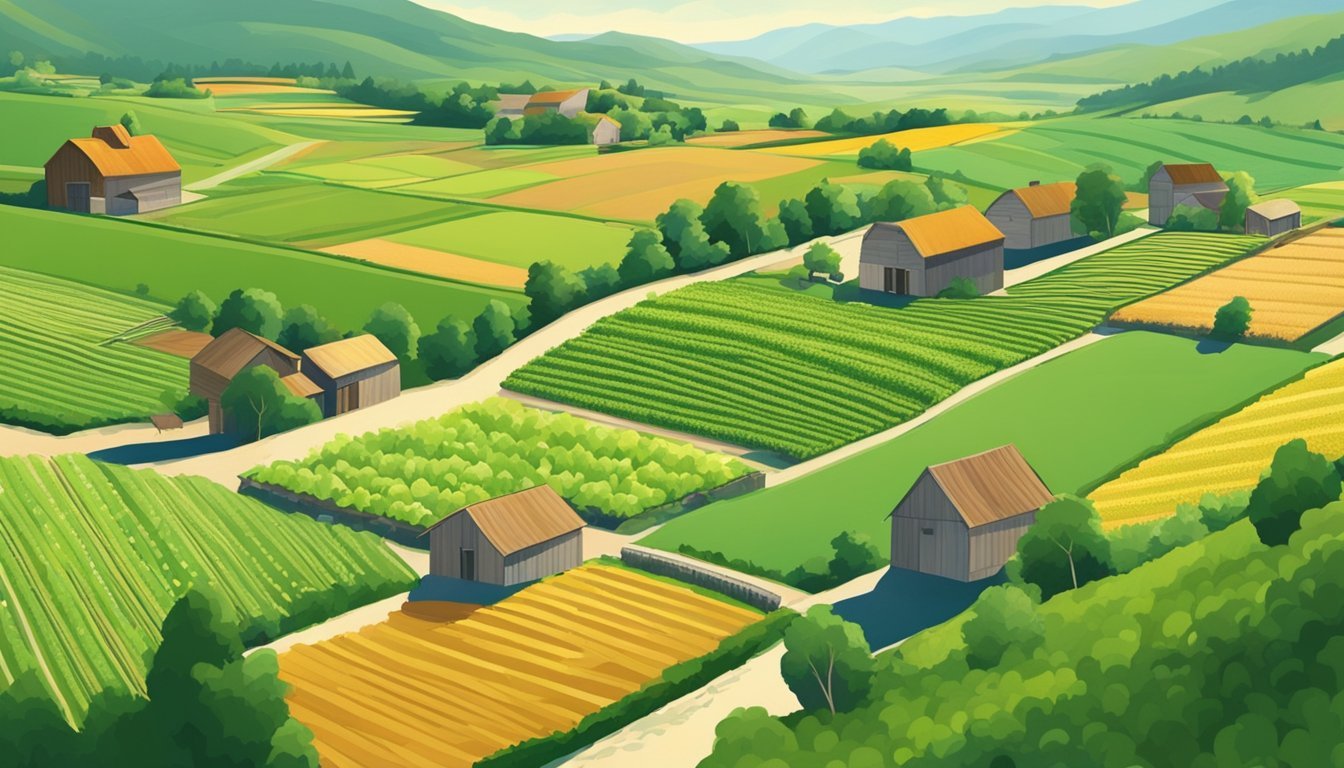Farming Communities in Utah
Sustaining Agriculture and Tradition
Utah offers an intriguing mosaic of farming communities that blend tradition with modern self-reliance. Notable among these is Riverbed Ranch, a pioneering off-grid community where residents can purchase two-acre lots with water rights, providing an inviting opportunity for those aiming to embrace a sustainable lifestyle. Riverbed Ranch exemplifies a modern approach to homesteading, complete with a K-12 school, community services, and planned greenbelts designed to foster communal cohesion and access to natural resources.
Smaller rural towns such as Vernon and Wallsburg maintain a quieter, more traditional lifestyle. Vernon, situated in Tooele County, remains a peaceful town with fewer than 300 residents despite the county's growth. Similarly, Wallsburg's charm lies in its small population and pastoral settings, reflecting Utah's rich agricultural heritage.
These communities showcase a dynamic spectrum of agricultural lifestyles in Utah, offering options that range from innovative, self-reliant living to serene, traditional farming practices. For anyone interested in agrarian living, Utah's farming communities provide varied and viable options, making it a prime location for those looking to reconnect with the land.
History of Farming in Utah
Farming in Utah has deep roots beginning with the initial settlement by Euro-American pioneers. The agricultural practices developed by these settlers laid the foundation for the thriving farming communities we see today.
Settlement and Agricultural Origins
On July 22, 1847, a scouting party from The Church of Jesus Christ of Latter-day Saints arrived in the Great Salt Lake Valley. By 1870, more than 18,000 followers had colonized the region. Early settlers prioritized agriculture to ensure their survival and establish self-sufficient communities.
The settlers displaced Native American populations and transformed the valley through irrigation and farming techniques. Brigham Young, the leader of the settlers, emphasized the importance of cooperation and communal effort.
Development of Farming Communities
By 1900, over 400 farm towns had been established in Utah. These towns often featured grid layouts with small, adjacent farms, reflecting a desire for organized and cooperative living. Many agricultural practices were influenced by both community and church guidance.
Irrigation projects and the creation of the Bureau of Reclamation in 1902 significantly boosted agricultural productivity. Crops such as sugar beets became prominent, and the formation of land cooperatives facilitated shared resources and efforts.
The Extension Service established in 1914 further promoted agricultural education and innovation, contributing to the enduring success of Utah's farming communities.
Geographical Overview
Utah's farming communities are characterized by their rural landscapes and proximity to natural landmarks. These aspects significantly influence the agricultural practices and lifestyle of the region.
Rural Landscapes and River Basins
Utah's rural landscapes are diverse, ranging from desertscapes to fertile river basins. The state features expansive farmland, particularly in areas like Box Elder County, which boasts over 1.2 million acres of farmland.
Key river basins, including those of the Jordan and Bear rivers, play a crucial role in irrigation.
Farmers utilize a combination of traditional and modern irrigation techniques, ensuring efficient water use. These basins not only support crop growth but also contribute to the picturesque landscapes that define rural Utah. The mosaic of interseeded grasses and mixed forage crops supports a robust agricultural ecosystem.
Proximity to National Parks
Utah's farming communities benefit from their proximity to several national parks, such as Zion, Bryce Canyon, and Arches National Park. These parks attract tourists, enhancing local economies and providing additional revenue streams for farms through agri-tourism.
Located at the foothills of Mount Timpanogos, many farming areas leverage their scenic vistas for community events and farm tours.
This blend of natural beauty and agriculture fosters a unique relationship between conservation and farming. The presence of national parks encourages sustainable farming practices to protect the environment, reflecting Utah's commitment to preserving its natural heritage while promoting agricultural growth.
Agricultural Practices
Utah's farming communities embrace both organic farming techniques and modern farming implementations to enhance sustainability and productivity. Farmers integrate traditional methods with innovative practices to achieve their agricultural goals.
Organic Farming Techniques
In Utah, organic farming is a key practice among local farmers who prioritize sustainability and health. They focus on using natural resources and avoiding synthetic chemicals, ensuring pesticide-free food. Composting plays a significant role, providing essential nutrients to the soil, thereby enhancing crop quality and yield.
Farmers also adopt crop rotation to maintain soil fertility and reduce pests naturally. Organic mulches are used to suppress weeds and retain soil moisture. These methods contribute to the environmental health and offer consumers safer and healthier food choices.
Modern Farming Implementations
Modern farming in Utah involves the use of advanced technologies and innovative practices. Precision agriculture is widely adopted, utilizing GPS and data analytics to optimize planting, watering, and harvesting. This improves efficiency and reduces waste.
Many farms employ high-efficiency irrigation systems, such as drip irrigation, to conserve water and ensure adequate hydration for crops. Additionally, greenhouses and aquaponics are increasingly popular, allowing farmers to grow crops year-round and in controlled environments. These implementations help in meeting the demands of urbanization and enhancing productivity in the agricultural sector.
Community and Family Life
The farming communities in Utah embody a blend of tradition and modernity, deeply emphasizing family bonds and self-reliance. With a rich history, these communities engage in various cultural and recreational activities fostered by their unique lifestyle.
Homesteading and Self-Reliance
Homesteading is a cornerstone of many Utah farming families, who prioritize self-reliance and sustainability. They often grow their own food, manage livestock, and maintain extensive gardens.
Many farms, such as the Thompson Family Farm in Spanish Fork, Utah, emphasize a heritage that dates back to the 1850s. Homesteading involves using traditional farming techniques passed down through generations, fostering a healthier lifestyle by consuming fresh, homegrown produce.
These communities also share resources and knowledge through local marketplaces and events. They may create their own homemade goods such as cheese, bread, and preserves, contributing to the local economy.
Cultural and Recreational Activities
Cultural and recreational activities play a significant role in these communities. Events often include community gatherings at local farms, like the ones at Red Acre Farm, that provide a space for residents to socialize and celebrate their shared heritage.
Recreational activities such as hiking and BMX bicycling are popular among both children and adults. With Utah's diverse landscape, these communities enjoy access to numerous hiking trails, enhancing their connection to nature and promoting physical health.
Local festivals and fairs are also common, featuring music, dancing, and traditional crafts. These events not only preserve cultural traditions but also strengthen community bonds. The Amish community, for example, emphasizes simplicity and family cohesion through these activities.
Economic Aspects
The farming communities in Utah are vital to the state's economy, influencing local markets and providing substantial economic benefits to rural areas.
Local Markets and Co-Ops
Local markets and cooperative initiatives allow Utah's farmers to sell directly to consumers. These ventures support community agriculture models where residents can purchase shares for seasonal produce allotments. This upfront payment helps cover risks associated with crop failure. Participation in co-ops also means access to resources and support from fellow farmers, leading to shared knowledge and reduced costs on supplies.
Impact of Agriculture on Rural Economy
Agriculture in Utah contributes significantly to the rural economy. According to the Census of Agriculture, in 2024, Utah had 17,386 farms with a market value of over $2.3 billion. The economic impact extends beyond direct sales. Local farmers and ranchers frequently purchase goods like tires, lumber, and fuel, directly supporting local businesses in rural communities. This spending circulates money within these communities, fostering economic stability and growth.
Sustainable Living
Sustainable living in farming communities ensures that residents minimize their ecological impact while maximizing self-sufficiency.
Community Supported Agriculture
Community Supported Agriculture (CSA) plays a major role in sustainable living. Residents pay upfront for their produce, supporting local farmers throughout the growing season. This model spreads the risk of crop failure among shareholders, fostering a sense of shared responsibility.
In Utah, many CSAs collaborate closely with local farmers, gardeners, and volunteers. This cooperation helps ensure the production of fresh, organic produce. Riverbed Ranch, a prominent farming community, integrates sub-coops that manage agricultural production on designated land parcels.
Since shareholders invest before the season begins, farmers can plan and potentially expand their crop varieties. This system also reduces the need for long-distance transportation, contributing to clean air and lowering carbon footprints.
Renewable Energy Integration
Renewable energy integration is critical for achieving a self-sustaining lifestyle. Utah's farming communities like Riverbed Ranch are adopting solar and wind energy to power their homes and agricultural activities. These renewable sources ensure a reliable electricity supply without harming the environment.
Many properties in these communities come with allocated water rights, supporting their essential water needs through sustainable practices. By utilizing renewable energy, these communities reduce dependency on non-renewable resources, further emphasizing their commitment to sustainability.
Reducing greenhouse gas emissions is central to this approach, directly contributing to cleaner air. This focus also aligns with the broader goals of minimizing environmental impact and promoting healthier living conditions for residents. Renewable energy systems may include solar panels, wind turbines, and even small-scale hydroelectric setups where applicable.
Collectively, these efforts showcase a significant movement towards sustainable living within Utah's farming communities.
Community Organization
Farming communities in Utah rely heavily on collaborative efforts and civic engagement to sustain agricultural practices and community well-being. Land co-ops and non-profit initiatives are pivotal in these endeavors.
Land Co-Ops and Non-Profit Initiatives
Utah OSR Land Co-Op and various non-profit organizations play significant roles in supporting local agriculture. These entities focus on sustainable land management and provide essential resources to farmers.
Land co-ops often offer shared land resources, enabling smaller farmers to access agricultural land at reduced costs. This collective approach helps in maintaining sustainable farming practices and increasing productivity.
Non-profits, such as CSA Utah, are vital in educating farmers and the community about sustainable agriculture. They often organize events and provide resources that facilitate the growth and success of local farms, ensuring that agriculture remains a viable livelihood.
Civic Engagement and Participation
Active civic participation is essential for the success of farming communities. Engaging local residents in agriculture-related activities helps foster a sense of community and shared responsibility.
Community Agriculture initiatives, often supported by Civic Participation programs, rely on volunteer efforts to operate and flourish. Volunteers contribute their time and skills, which is crucial for the sustainability of these projects.
Events such as the Community Supported Agriculture Open House are instrumental in promoting local farms. These gatherings offer opportunities for residents to learn about and support farming, enhancing civic engagement and strengthening community ties.
Challenges and Opportunities
Utah's farming communities face a range of challenges related to environmental and regulatory conditions while also experiencing growth driven by technological advancements and community initiatives.
Environmental and Regulatory Hurdles
Farming in Utah involves managing scarce water resources due to its arid climate. Water conservation becomes crucial as new development projects compete for these limited supplies. Regulatory hurdles also add complexity, with farmers needing to navigate zoning laws and environmental regulations. As farmland diminishes due to urban development, preserving fertile soil remains a top concern. Additionally, ensuring the safety of farm workers and maintaining sustainable practices requires continuous effort and financial investment.
Advancements and Community Growth
Technological advancements, such as the use of Starlink for internet access, have significantly impacted farming communities. Enhanced connectivity improves farm management through precision agriculture and real-time data analysis. Community agriculture programs foster engagement and create new job opportunities, contributing to economic stability. Local initiatives spearheaded by entities like the Utah Natural Meat and Milk help integrate traditional farming practices with modern techniques. These efforts not only sustain agriculture but also strengthen social bonds within the community.
Educational and Social Infrastructure
Educational and social infrastructure are critical to the success and cohesion of farming communities in Utah. These elements provide essential support for learning and community engagement, fostering a well-rounded and resilient population.
Schooling and Educational Services
In Utah's farming communities, K-12 schools play a vital role. Local schools often serve as the educational hub, offering tailored programs to meet the specific needs of rural students.
Agriculture-focused curriculums are prevalent, ensuring students gain practical knowledge alongside standard academic subjects.
Extracurricular activities related to farming, such as 4-H clubs, provide hands-on learning experiences. These programs teach crucial skills in agriculture, leadership, and teamwork.
Accessibility to education remains a priority, with efforts to improve infrastructure and provide transportation services for students in remote areas.
Social Networking and Support Systems
Farming communities in Utah benefit from robust social networks and various support systems. Community-supported agriculture (CSA) models enable residents to connect with local farmers, ensuring reliable access to fresh produce.
Local growing sites, like the Thompson Family Farm, often host community events, fostering a strong sense of belonging and collaboration.
Co-Op stores serve as community hubs, offering spaces for social gatherings and cooperative purchasing. These stores facilitate support networks and promote economic sustainability within the community.
Moreover, volunteer organizations and local workshops frequently offer assistance and resources, bolstering the social fabric of these rural areas.
Agriculture and Tourism
Utah's farming communities are increasingly integrating tourism into their operations, enhancing both visitor experiences and local economies. This section explores how farms engage tourists and identify key attractions that draw in visitors.
Agritourism and Visitor Engagement
Farming communities in Utah have embraced agritourism as a way to boost income and educate the public about agriculture. Local farms often host events, such as harvest festivals and educational tours, that allow visitors to experience farm life firsthand.
For instance, Thompson Family Farm in Spanish Fork offers on-farm events that foster a sense of community. This not only supplements the farm's income but also promotes environmental and social benefits. The Utah government supports these efforts through initiatives like Utah’s Own program, which helps promote local agricultural products.
Farms as Tourist Attractions
Many farms in Utah have transformed into tourist destinations, attracting visitors with unique experiences. Red Acres Farm in Cedar City is one such farm, known for its sustainable farming practices and engaging tours. It began as a homeschool project and has grown into a notable attraction.
Farms near popular destinations, such as Bryce Canyon National Park and Capitol Reef National Park, have also set up RV Parks to accommodate visitors. These farms often offer fresh produce and farm-to-table dining experiences. Additionally, visitors can learn about agricultural practices and enjoy scenic views that these locations have to offer.
By integrating tourism, Utah’s farming communities are securing a sustainable future while providing educational and recreational opportunities for visitors.
Contemporary Farm Operations
Modern farming communities in Utah are blending traditional wisdom with cutting-edge technology and innovative strategies to sustain and expand their agricultural ventures.
Technology Integration in Agriculture
Utah farms are leveraging advanced technology to improve efficiency and crop yields. Precision agriculture, involving GPS and remote sensing, helps optimize field-level management through data analytics. Automated systems manage irrigation, ensuring water conservation in the Greenbelt Area.
Drones monitor crop health, while farm management software enables real-time tracking of livestock and crop conditions. Smart barns equipped with sensors create optimal environments for animals, increasing productivity and welfare. These innovations are transforming traditional practices into modern, sustainable operations.
Diversification of Farm Revenue
Farming communities are not solely dependent on traditional crop sales. They are introducing agritourism activities such as farm tours, which provide additional income streams. Honeybee-friendly trees are planted to support apiculture, tapping into the honey market.
Furthermore, some farms are adopting Community Supported Agriculture (CSA) models, where consumers pre-purchase shares of the farm's produce, ensuring stable revenue. Farmers engage in value-added production, such as making jams, cheeses, and artisanal goods. Utah's proprietary occupancy agreements allow for innovative lease arrangements, supporting diverse revenue channels.
Modern farmers in Utah are finding creative ways to enhance financial stability and community engagement through these varied activities.
Ecological Considerations
Farming communities in Utah face unique ecological challenges and opportunities. Their approach to agriculture must balance productivity with environmental stewardship, ensuring the sustainability of local ecosystems and biodiversity.
Farming with the Ecosystem
Farmers in Utah adopt strategies that work harmoniously with natural processes. Agroecology plays a significant role in this approach, integrating ecological principles into agricultural practices. This ensures soil health, water conservation, and resilient crop systems.
Cattle and sheep farming practices are tailored to Utah's diverse landscape. Rotational grazing is widely used to prevent overgrazing and promote healthy grasslands. This not only supports livestock health but also maintains habitat integrity for wildlife.
Local initiatives, such as the Utah Grazing Improvement Program, underscore the importance of sustainable resource management. By investing in better water supplies and native grass species, these programs benefit both agriculture and the broader ecosystem.
Wildlife and Biodiversity
Maintaining biodiversity is crucial for the ecological balance in Utah's farming areas. Efforts are made to preserve habitats that support a wide range of species. Farmers often collaborate with conservation organizations to protect wildlife corridors and nesting sites.
Utah's unique topography, including its mountain vistas and red rock formations, provides essential habitats. Agricultural practices must consider these natural features to minimize disruption. Wildlife-friendly farming practices include hedgerows and buffer strips, which offer shelter and food for various species.
Agricultural lands are also critical for pollinators. Bees and other insects thrive in these environments when farmers plant cover crops and flowering plants. This enhances biodiversity and supports crop yields through natural pollination processes.











